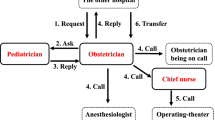Abstract
Purpose: The objective of this study was to investigate the effect of decision-to-delivery interval of crash emergency cesarean section on Apgar and umbilical artery pH in a level-3 university hospital. Materials and methods: In a retrospective analysis, all women undergoing “crash” emergency cesarean section were evaluated. Emergency cesarean sections were performed in the delivery room. Data relating to indication, Apgar score, arterial cord pH, and time intervals between decision-to-deliver and actual delivery were collected retrospectively. Results: All 109 crash emergency cesarean sections were performed within a decision-to-delivery time of 30 min. The median (with 10–90th percentile) time was 10 min (5–19). Thirty-three (30.3%) of the emergency cesarean sections had a gestational age below 32 weeks and 60 (55%) below 37 weeks. An abnormal fetal heart rate pattern was noted in most of the cases (91%). Prolapsed cord (21%) and placental abruption (20%) were the most frequent reasons for emergency cesarean section but in one-fourth (25.7%) no morphological reason could be identified. Very short decision-to-delivery times below 20 min were inversely correlated to fetal outcome, i.e., lower umbilical blood pH and Apgar scores (P<0.01). Conclusion: The 30-min standard for the decision-to-delivery time interval set by Anglo-American countries may be a feasible guideline at least for level-3 hospitals. The 20-min interval set by the German Society of Gynecology and Obstetrics could not be achieved in all cases. The positive effect of very short intervals on neonatal outcome still needs to be proven.


Similar content being viewed by others
References
American College of Obstetricians and Gynecologists (1989) Committee on Professional Standards. In: Standards for Obstetric-Gynecologic Services, 7th edn. Washington, DC
Canadian Medical Association (1986) Indications for cesarean section: final statement of the panel of the National Consensus Conference on aspects of cesarean birth. CMAJ 134:1348–1352
Royal College of Obstetricians and Gynaecologists (1995) Report of a joint working group: organisational standards for maternity services. RCOG Press, London
Chauhan SP, Mobley JA, Hendrix NW, Magann EF, Devoe LD, Martin JN Jr (2000) Cesarean delivery for suspected fetal distress among preterm parturients. J Reprod Med 45:395–402
Chauhan SP, Roach H, Naef RW II, Magann EF, Morrison JC, Martin JN Jr (1997) Cesarean section for suspected fetal distress. Does the decision–incision time make a difference? J Reprod Med 42:347–352
Choate JW, Lund CJ (1968) Emergency cesarean section: an analysis of maternal and fetal results in 177 operations. Am J Obstet Gynecol 100:703–715
Dyer RA, Els I, Farbas J, Torr GJ, Schoeman LK, James MF (2003) Prospective, randomized trial comparing general with spinal anesthesia for cesarean delivery in preeclamptic patients with a nonreassuring fetal heart trace (see also discussion pp5A–6A). Anesthesiology 99:561–569
Halsey H, Douglas R (1957) Fetal distress and fetal death in labor. Surg Clin North Am 37:421–434
Hillemanns P, Hasbargen U, Strauss A, Schulze A, Genzel-Boroviczeny O, Hepp H (2003) Maternal and neonatal morbidity of emergency caesarean sections with a decision-to-delivery interval under 30 minutes: evidence from 10 years. Arch Gynecol Obstet 268(3):136–141
Hood DD, Curry R (1999) Spinal versus epidural anesthesia for cesarean section in severely preeclamptic patients: a retrospective survey. Anesthesiology 90:1276–1282
MacKenzie IZ, Cooke I (2001) Prospective 12 month study of 30 minute decision to delivery intervals for “emergency” caesarean section. BMJ 322:1334–1335
MacKenzie IZ, Cooke I (2002) What is a reasonable time from decision-to-delivery by caesarean section? Evidence from 415 deliveries. BJOG 109:498–504
MacLennan A (1999) A template for defining a causal relation between acute intrapartum events and cerebral palsy: international consensus statement. BMJ 319:1054–1059
Roemer VM, Heger Romermann G (1992) Emergency cesarean section—basic data. Z Geburtshilfe Perinatol 196:95–99
Roemer VM, Heger Romermann G (1992) What factors modify the condition of the newborn infant in emergency cesarean section? Z Geburtshilfe Perinatol 196:141–151
Roemer VM, Heger-Romermann G (1993) Clinic structure and timely management of emergency cesarean section—reference values and recommendations. Z Geburtshilfe Perinatol 197:153–161
Schauberger CW, Rooney BL, Beguin EA, Schaper AM, Spindler J (1994) Evaluating the thirty minute interval in emergency cesarean sections. J Am Coll Surg 179:151–155
Scheller A, Terinde R (1992) Comparison of the rate of complications after primary, secondary and emergency Cesarean section. Z Geburtshilfe Perinatol 196:253–260
Spencer MK, MacLennan AH (2001) How long does it take to deliver a baby by emergency Caesarean section? Aust N Z J Obstet Gynaecol 41:7–11
Tuffnell DJ, Wilkinson K, Beresford N (2001) Interval between decision and delivery by caesarean section—are current standards achievable? Observational case series. BMJ 322:1330–1333
Wallace DH, Leveno KJ, Cunningham FG, Giesecke AH, Shearer VE, Sidawi JE (1995) Randomized comparison of general and regional anesthesia for cesarean delivery in pregnancies complicated by severe preeclampsia. Obstet Gynecol 86:193–199
Author information
Authors and Affiliations
Corresponding author
Rights and permissions
About this article
Cite this article
Hillemanns, P., Strauss, A., Hasbargen, U. et al. Crash emergency cesarean section: decision-to-delivery interval under 30 min and its effect on Apgar and umbilical artery pH. Arch Gynecol Obstet 273, 161–165 (2005). https://doi.org/10.1007/s00404-005-0045-7
Received:
Accepted:
Published:
Issue Date:
DOI: https://doi.org/10.1007/s00404-005-0045-7




